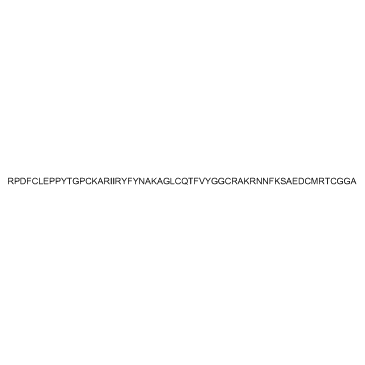| Description |
Aprotinin is a bovine pancreatic trypsin inhibitor (BPTI) inhibitor which inhibits trypsin and chymotrypsin with Kis of 0.06 pM and 9 nM, respectively.
|
| Related Catalog |
|
| Target |
Ki: 0.06 pM (Trypsin), 9 nM (Chymotrypsin)[1]
|
| In Vitro |
Aprotinin, a serine protease inhibitor isolated from bovine lung, is a complex protease inhibitor that is an antifibrinolytic, inhibits contact activation, and decreases the inflammatory response to cardiopulmonary bypass[2]. Aprotinin inhibits trypsin (bovine, Ki= 0.06 pM), chymotrypsin (bovine, Ki= 9 nM), plasmin (human, 0.23 nM)[1]. Aprotinin is also a competitive protein inhibitor of NOS activity. It inhibits NOS-I and NOS-II with Ki values of 50 μM and 78 μM, respectively[3]. Aprotinin significantly inhibits fibrinolysis with an IC50 of 0.16±0.05 μM[4].
|
| In Vivo |
High dose aprotinin can reduce blood loss and transfusion requirements associated with primary cardiac procedures such as coronary artery bypass graft (CABG) or heart valve replacement surgery[5]. Aprotinin inhibits thrombus formation in a dose-dependent manner. Aprotinin at a dose of 1.5 mg kg-1 (bolus) and 3 mg kg-1 h-1 infusion (maintenance infusion) causes a tendency towards a reduction in bleeding time. Aprotinin significantly reduces the bleeding time starting at a dose of 3 mg kg-1 bolus plus 6 mg kg-1 h-1 showing a reduction of approximately 84%±2.9%. At the highest dose of 5 mg kg-1 and 10 mg kg-1 h-1, the strongest effects are observed[4]. Aprotinin may affect tumor necrosis factor-alpha (TNF) levels. Soluble TNFRI levels are significantly increased following I/R in the aprotinin treated wild type mice and not detected in all TNFRInull mice[6].
|
| Animal Admin |
Rats: Male Wistar rats (180-220 g) are used in the study. Aprotinin is dissolved in physiological saline. Aprotinin is administered by bolus injection followed by a maintenance infusion. The doses given are 1.5 mg kg-1 and 3 mg kg-1 h-1, 3mg kg-1 and 6 mg kg-1 h-1 up to 5 mg kg-1 and 10 mg kg-1 h-1. Plasma concentrations for the two agents are assessed by pharmacokinetic studies in rats[4]. Mice: An intact mouse model of ischemia/reperfusion (30 min-I/60 min-R) is used and left ventricular peak + dP/dt is measured in wild type mice (WT, C57BL/6; n=10), WT mice with aprotinin (4mL/kg; n=10), transgenic mice devoid of the TNFRI (TNFRInull; n=10), and TNFRInull with aprotinin (n=10)[6].
|
| References |
[1]. Fritz H, et al. Biochemistry and applications of aprotinin, the kallikrein inhibitor from bovine organs. Arzneimittelforschung. 1983;33(4):479-94. [2]. Levy JH, et al. Efficacy and safety of aprotinin in cardiac surgery. Orthopedics. 2004 Jun;27(6 Suppl):s659-62. [3]. Venturini G, et al. Aprotinin, the first competitive protein inhibitor of NOS activity.Biochem Biophys Res Commun. 1998 Aug 10;249(1):263-5 [4]. Sperzel M, et al. Evaluation of aprotinin and tranexamic acid in different in vitro and in vivo models of fibrinolysis, coagulation and thrombus formation. J Thromb Haemost. 2007 Oct;5(10):2113-8. Epub 2007 Jul 31. [5]. Davis R, et al. Aprotinin. A review of its pharmacology and therapeutic efficacy in reducing blood loss associated withcardiac surgery. Drugs. 1995 Jun;49(6):954-83. [6]. Sabbagh MJ, et al. Aprotinin exacerbates left ventricular dysfunction after ischemia/reperfusion in mice lacking tumor necrosis factor receptor I. J Cardiovasc Pharmacol. 2008 Oct;52(4):355-62.
|


